Table of Contents
ToggleKnown as the leading cloud, AWS or Amazon Web Service is the world’s most comprehensive and broadly adopted cloud, offering over 200 fully featured services from data centers globally. It offers services more than any other platform and includes a wholesome mixture of infrastructure-as-a-service (IaaS), platform-as-a-service (PaaS), and packaged software-as-a-service (SaaS) offerings. AWS mainly presents tools for computing power, database storage, and content delivery services.
What is Amazon Web Service?
Amazon.com Web Services was launched in 2002, leveraging the internal infrastructure initially developed to support its online retail endeavors. By 2006, it commenced providing its hallmark Infrastructure as a Service (IaaS) solutions. AWS emerged as a pioneering entity in introducing a scalable pay-as-you-go cloud computing model, delivering users with on-demand computing, storage, and throughput capabilities. AWS is being used by millions of customers, including fast-growing startups, big companies, and government agencies. They’re using it to save money, be more flexible, and come up with new ideas quickly.
AWS has established such a dominant presence in the computing industry that it has outstripped its competitors by a significant margin. According to one independent analyst’s report for the first quarter of 2021, AWS commands over a third of the market share, accounting for 32.4%, while Azure trails behind at 20%, and Google Cloud holds 9%.
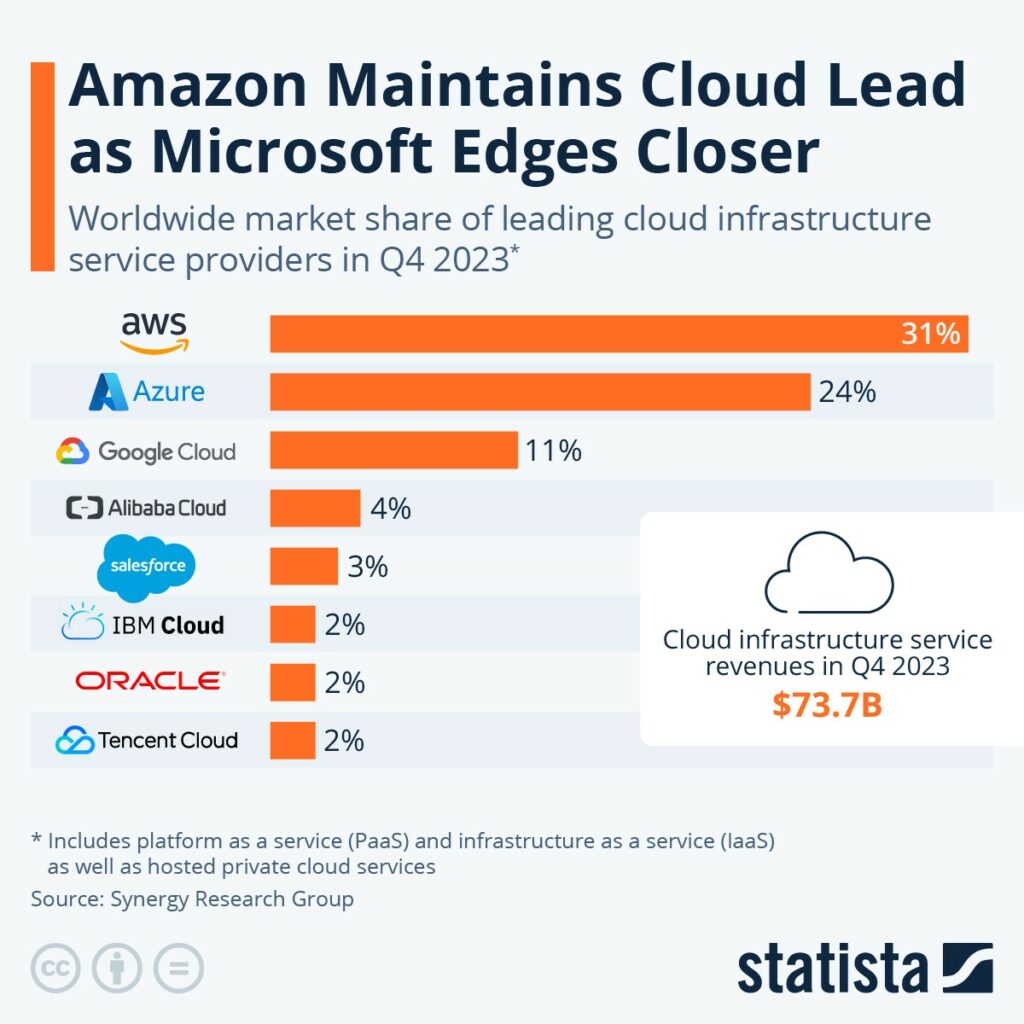
Image source: statista.com
What features does AWS provide?
AWS offers a broader range of services and features compared to any other cloud provider. These include basic infrastructure services like computing, storage, and databases, as well as newer technologies such as machine learning, artificial intelligence, data analytics, and Internet of Things solutions.
The Basic Features of AWS
1. Functionality
AWS stands out among other cloud providers with its extensive range of services and features, covering everything from basic infrastructure like computing, storage, and databases to cutting-edge technologies such as machine learning, artificial intelligence, data analytics, and the Internet of Things. This diversity makes it quicker, simpler, and more economical to migrate your current applications to the cloud and create almost anything you can envision.
Furthermore, AWS boasts the most comprehensive functionality within these services. For instance, it provides the broadest selection of purpose-built databases tailored for various applications, enabling you to select the most suitable tool for optimal cost and performance.
2. Large Community
AWS boasts the largest and most vibrant community, with millions of active customers and tens of thousands of partners worldwide. Customers from virtually every industry and of all sizes, ranging from startups to enterprises and public sector organizations, are utilizing AWS for a myriad of purposes. The AWS Partner Network (APN) encompasses thousands of systems integrators with expertise in AWS services with other tens of thousands of independent software vendors (ISVs) who tailor their technology to integrate seamlessly with AWS.
3. Security
AWS is designed to offer the most adaptable and secure cloud computing environment currently accessible. This foundational infrastructure is constructed to meet the stringent security standards demanded by the military, major financial institutions, and other highly sensitive entities. This assurance is reinforced by an extensive array of cloud security tools, encompassing over 300 services and features dedicated to security, compliance, and governance. Additionally, there are 143 security standards and compliance certifications, ensuring comprehensive protection for our customers’ data and operations.
4. Fast Innovation
By utilizing AWS, you gain access to cutting-edge technologies that enable faster experimentation and innovation. We are constantly pushing the boundaries of innovation, introducing brand-new technologies that can revolutionize your business. For instance, in 2014, AWS led the way in serverless computing with the introduction of AWS Lambda, allowing developers to execute their code without the hassle of provisioning or managing servers. AWS developed Amazon SageMaker, a fully managed machine learning service that empowers developers and scientists, regardless of their prior experience, to utilize machine learning effectively.
5. Foolproof Operational Expertise
AWS offers unparalleled experience, maturity, reliability, security, and performance that you can rely on for your critical applications. With over 17 years of providing cloud services to millions of customers worldwide across diverse use cases, AWS boasts the most extensive operational experience at a scale unmatched by any other cloud provider.
How does Amazon Web Services power Customer Innovation?
With AWS services like Amazon Pinpoint and Amazon Personalize, businesses can efficiently develop and implement tailored recommendations and sophisticated user segmentation at a large scale by leveraging machine learning (ML) and messaging automation. This encompasses SMS, email, push notifications, in-app messaging, and voice communication channels. The following are the verticals where Amazon Web Services have mastered the art of boosting Customer Innovation:
1. Advertising and Marketing

2. Aerospace and Satellite
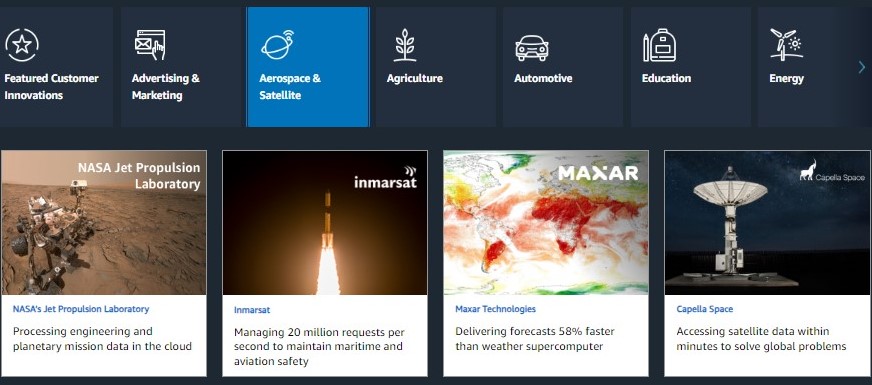
3. Automotive

4. Education

5. Energy
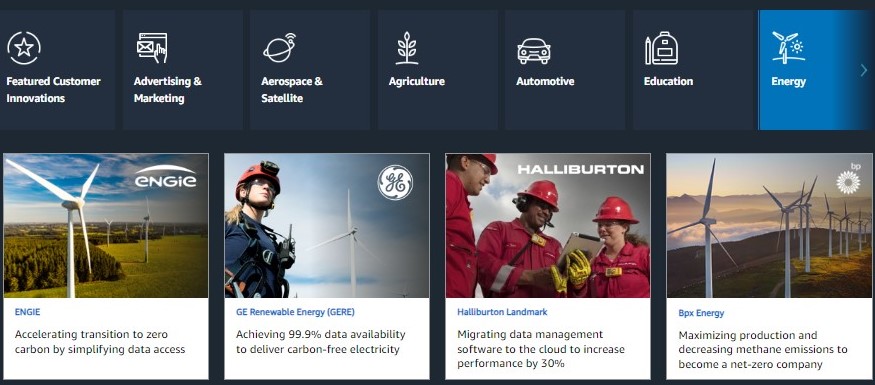
6. Financial Services

7. Government
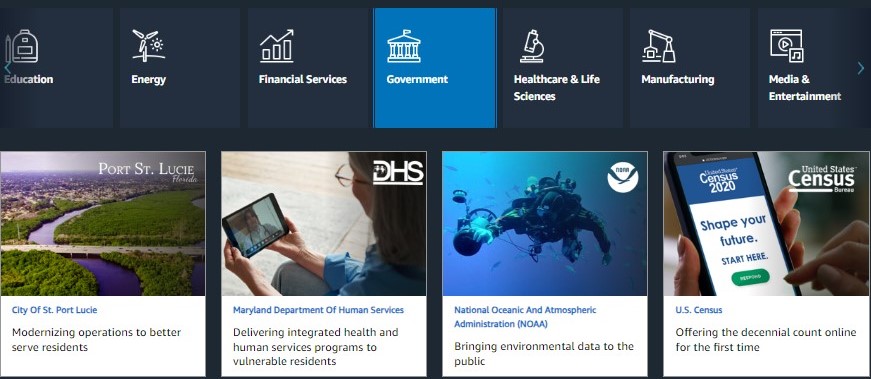
7. Healthcare & Life Sciences

8. Manufacturing

9. Media and Entertainment

10. Retail and Consumer Packaged Goods
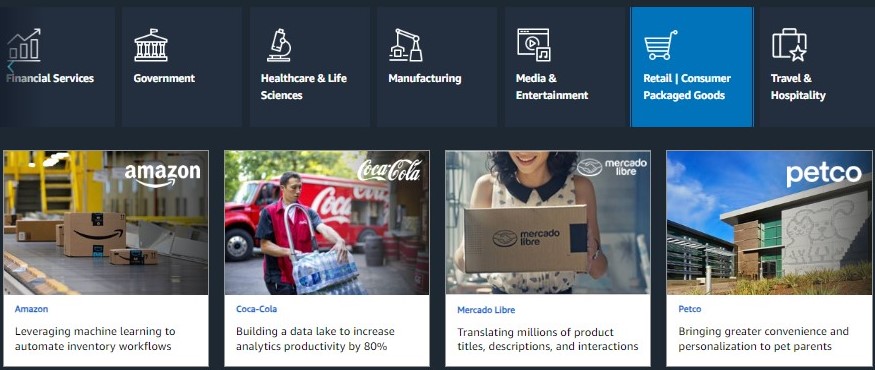
11. Travel and Hospitality

Images are collected from: aws.amazon.com
What are AWS Services?
Amazon Web Services provides an extensive array of cloud computing services designed to address diverse IT requirements for organizations. The mentioned services are merely a glimpse of the comprehensive suite offered by AWS. Continuously evolving, AWS introduces new services and features that cater to the ever-changing demands of businesses and developers worldwide. Each service presents various configurations and options, enabling organizations to construct and oversee applications, data, and infrastructure with scalability and cost-effectiveness in mind. Below is a brief overview of some essential AWS services.
AWS Compute Service
AWS Compute services, including Amazon EC2, Elastic Beanstalk, Fargate, and Lambda, provide versatile tools for efficiently developing, deploying, and scaling applications in the cloud. The AWS Compute Services play a crucial role in driving innovation and flexibility in operations. Let’s explore them further.
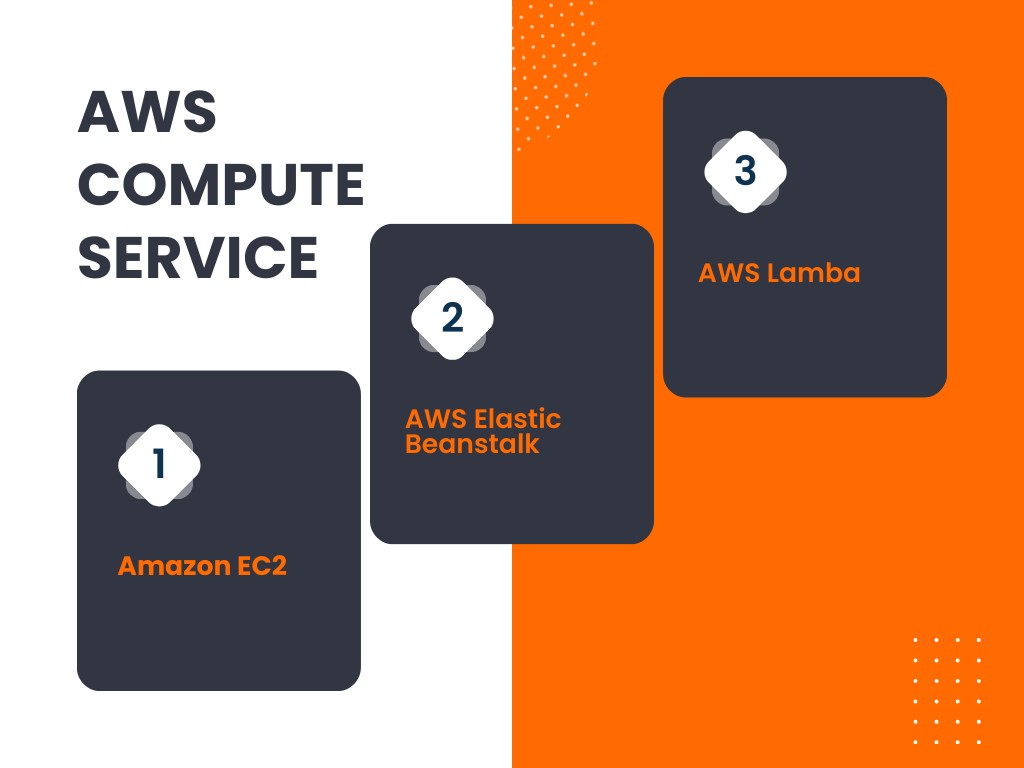
a) Amazon EC2- Amazon Elastic Compute Cloud, provides resizable virtual servers for running applications. Users can customize these instances, making EC2 ideal for tasks like web hosting and managing scalable workloads. It offers flexibility, scalability, and cost-effectiveness for various cloud computing needs.
b) AWS Fargate- It simplifies container deployment and management by handling underlying infrastructure, making it suitable for running containers at scale with efficient resource utilization.
c) AWS Lambda- This allows running code without managing servers, perfect for event-driven applications and microservices. It automatically scales and manages infrastructure, charging only for compute time used, allowing you to focus solely on writing code and responding to events.
Amazon Storage Services
Storage is a cornerstone of AWS, essential for data management in applications. These services provide flexible, scalable, and secure storage options, ensuring the reliability and availability of data.
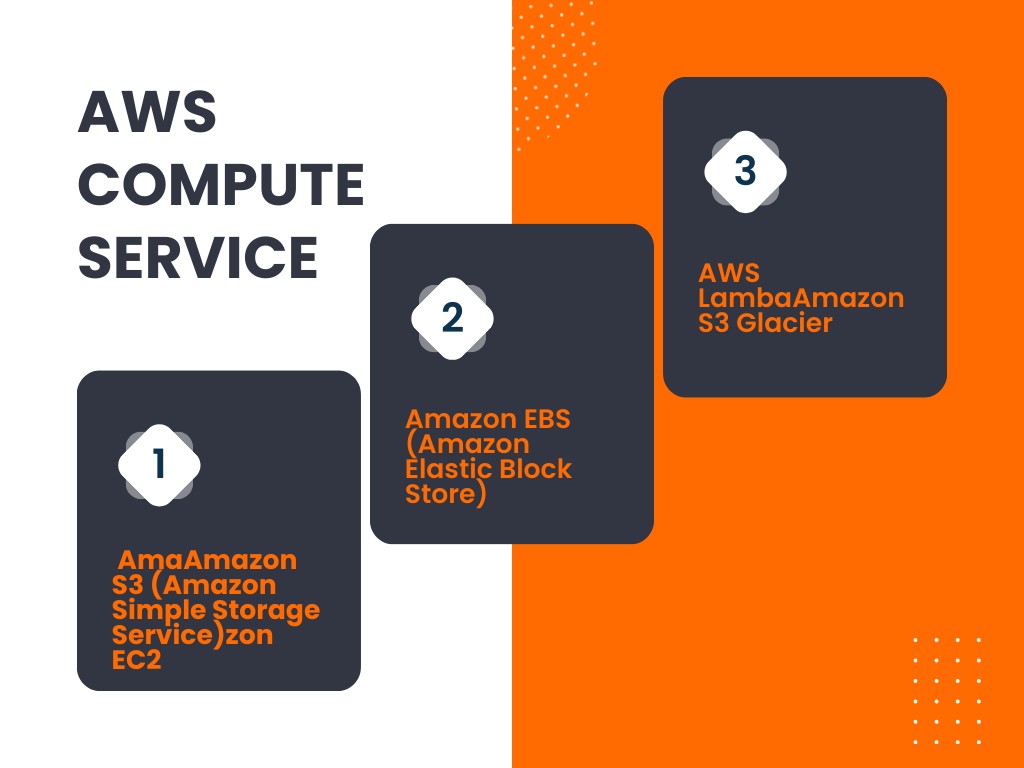
Amazon S3: Scalable, secure object storage service for various data types, essential for hosting websites and backing up critical information.
Amazon EBS: Reliable block storage service for Amazon EC2 instances, offering persistent volumes and snapshot capabilities for backup.
Amazon S3 Glacier: Cost-effective archival storage for long-term data retention, suitable for preserving rarely accessed data such as financial records or compliance documents.
AWS Database Services
AWS offers various end-to-end database services to manage data needs, each with features like backup and scalability. Here are some key services:
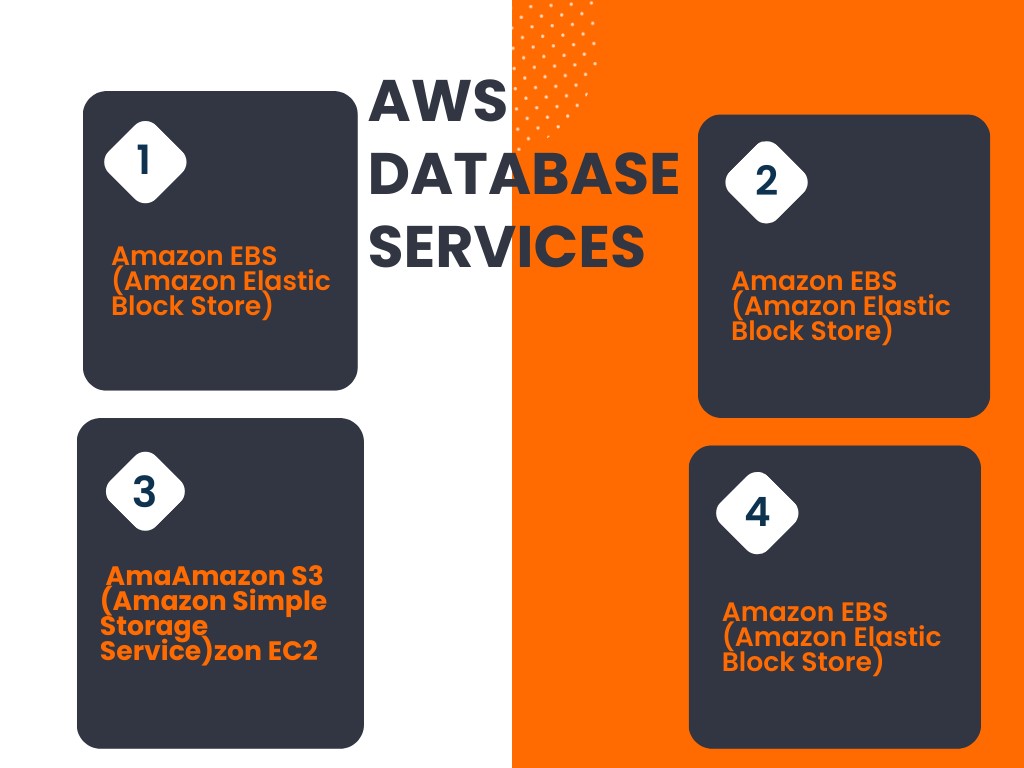
Amazon RDS: A fully managed database service supporting various relational database engines. It handles administration tasks and ensures reliable data storage.
Amazon DynamoDB: A NoSQL database service for seamless storage and retrieval of document and key-value data, ideal for high-performance applications.
Amazon ElastiCache: A managed caching service for enhancing web application performance by storing frequently accessed data in memory.
Amazon Redshift: A data warehousing service optimized for large-scale analytics, allowing efficient storage and analysis of massive datasets.
AWS Networking & Content Delivery Services
These services ensure reliable data transfer and content distribution:
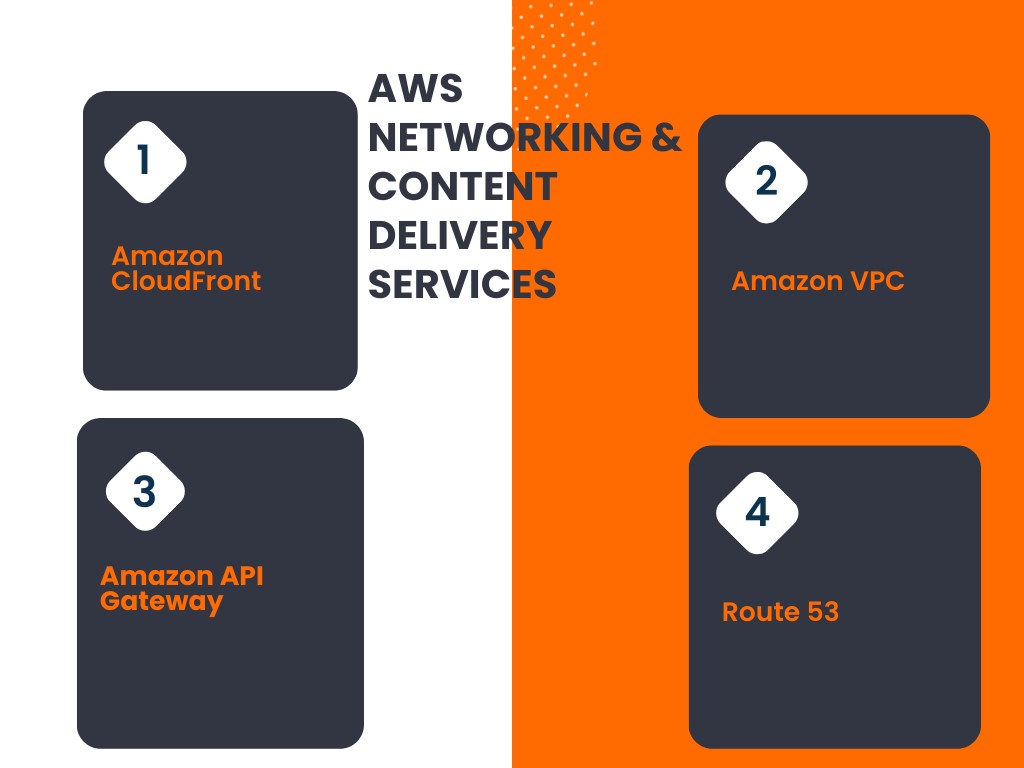
Amazon CloudFront: A content delivery network (CDN) for fast and secure content distribution, enhancing user experience.
Amazon VPC: A networking service for creating isolated and secure network environments, crucial for connecting AWS services securely.
Amazon API Gateway: A managed service for creating, managing, and deploying APIs at scale, simplifying application development.
AWS Route 53: A scalable DNS web service for managing domain names and routing incoming web traffic to AWS resources.
Amazon ELB: A load-balancing service for distributing incoming application traffic across multiple targets, enhancing application availability.
AWS Analytics Services
These services help extract insights from data:
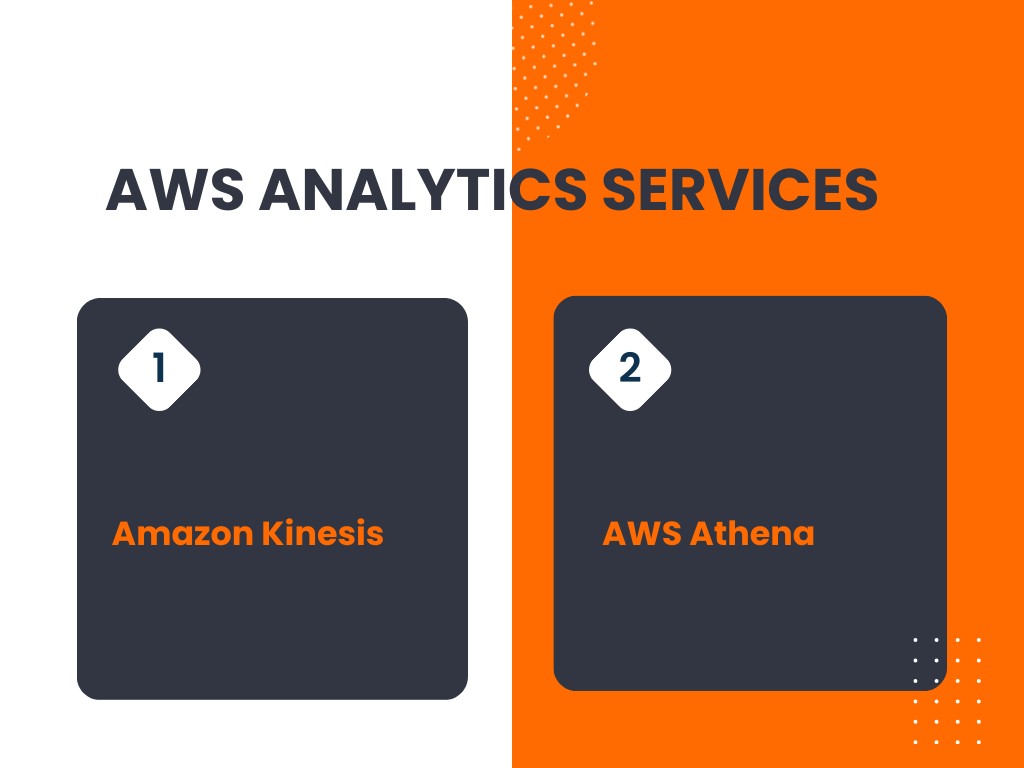
Amazon Kinesis: This one-of-a-kind platform is used for real-time data streaming and analytics, suitable for IoT and real-time monitoring applications.
AWS Athena: An interactive query service for analyzing data stored in Amazon S3 using standard SQL queries, ideal for ad-hoc querying and data exploration.
AWS Management Services
These services aid in controlling and optimizing AWS resources:
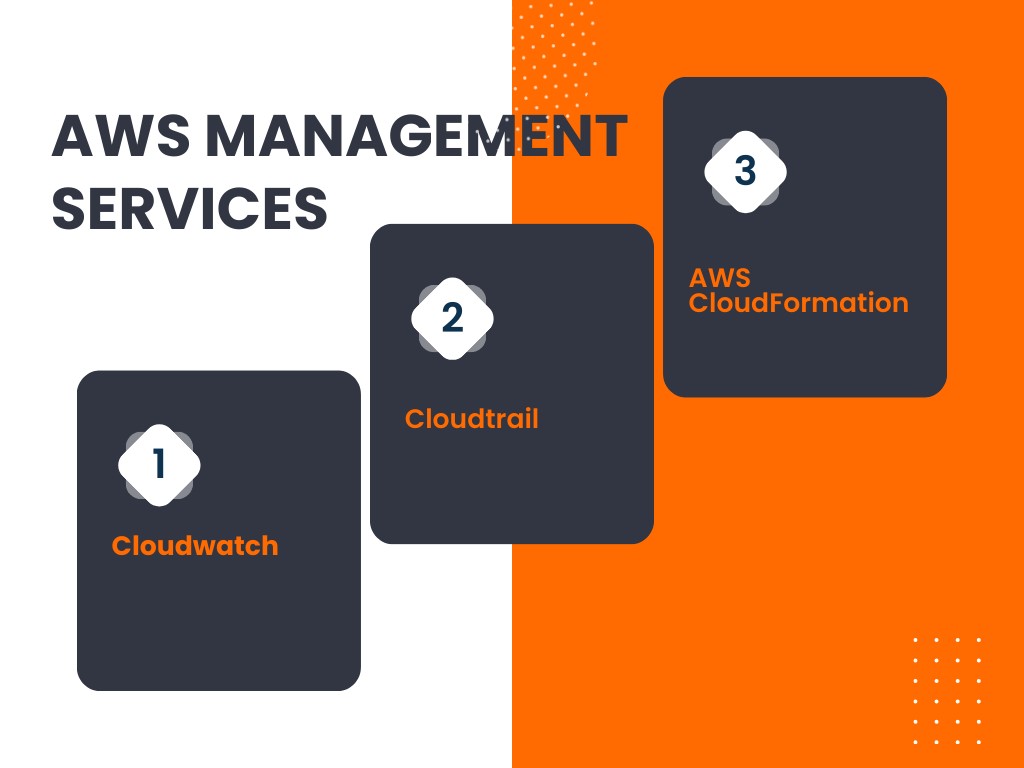
Amazon CloudWatch: A monitoring service for tracking metrics and logs, providing insights into application performance.
AWS CloudFormation: A service for defining, deploying, and managing AWS infrastructure as code, ensuring consistent resource provisioning.
AWS CloudTrail: A service for recording AWS API activity for security, compliance, and operational analysis purposes.
AWS Migration Services
These services help migrate applications and data to the AWS cloud:
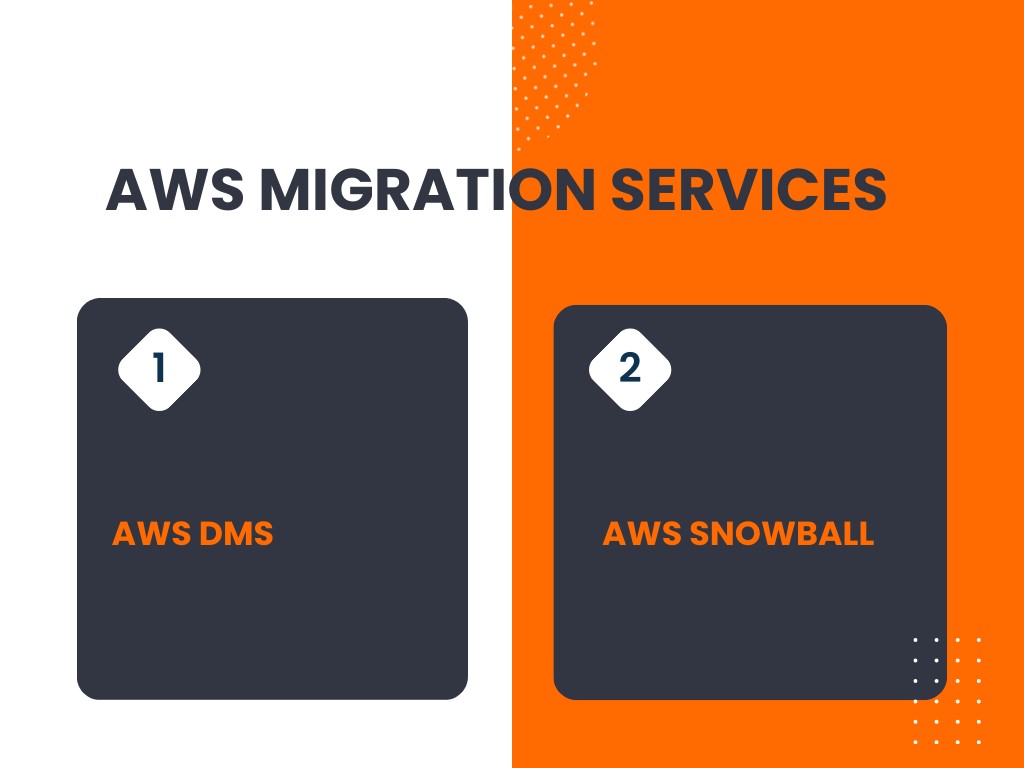
AWS Database Migration Service: A fully managed service for streamlining database migrations to AWS, ensuring minimal downtime.
AWS Snowball: A physical data transport solution for transferring large volumes of data to and from the AWS cloud, suitable for limited network bandwidth scenarios.
AWS Security, Identity & Compliance Services
These services enhance security and compliance:
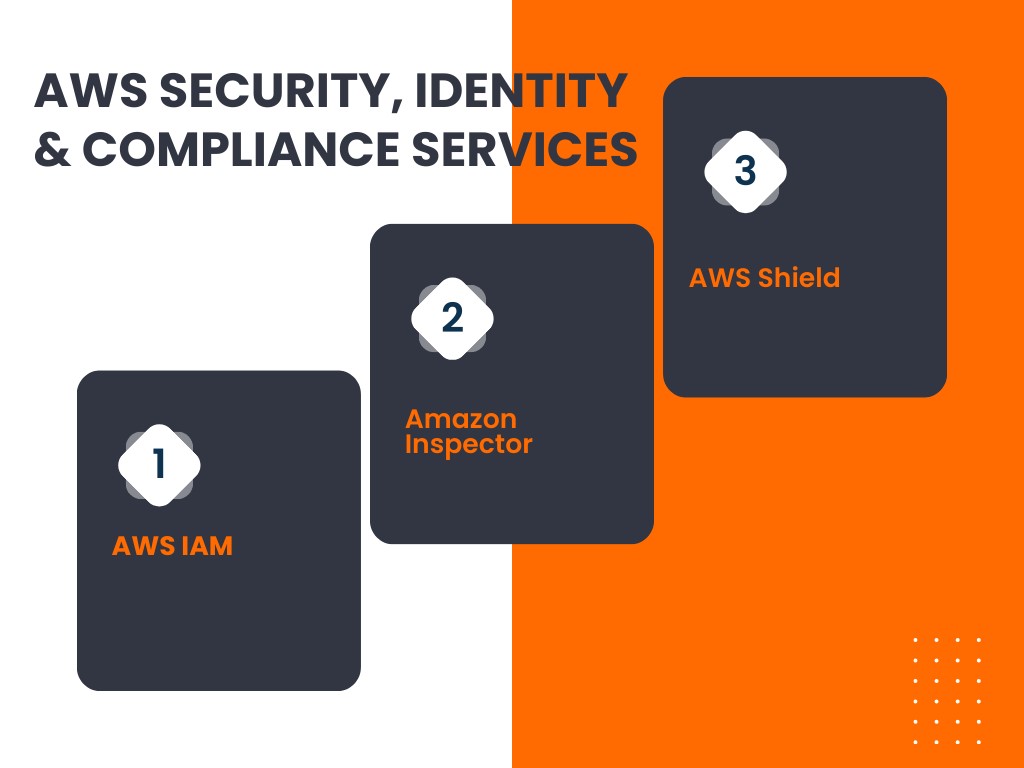
AWS Identity and Access Management (IAM): This is used as a service for managing secure access to AWS resources, enabling fine-grained control over permissions.
Amazon Inspector: An automated security assessment service for discovering and addressing security issues in applications and resources.
AWS Shield: A managed DDoS protection service for safeguarding applications running on AWS from DDoS attacks.
AWS Application Integration Services
These services facilitate application integration with various AWS and external services:
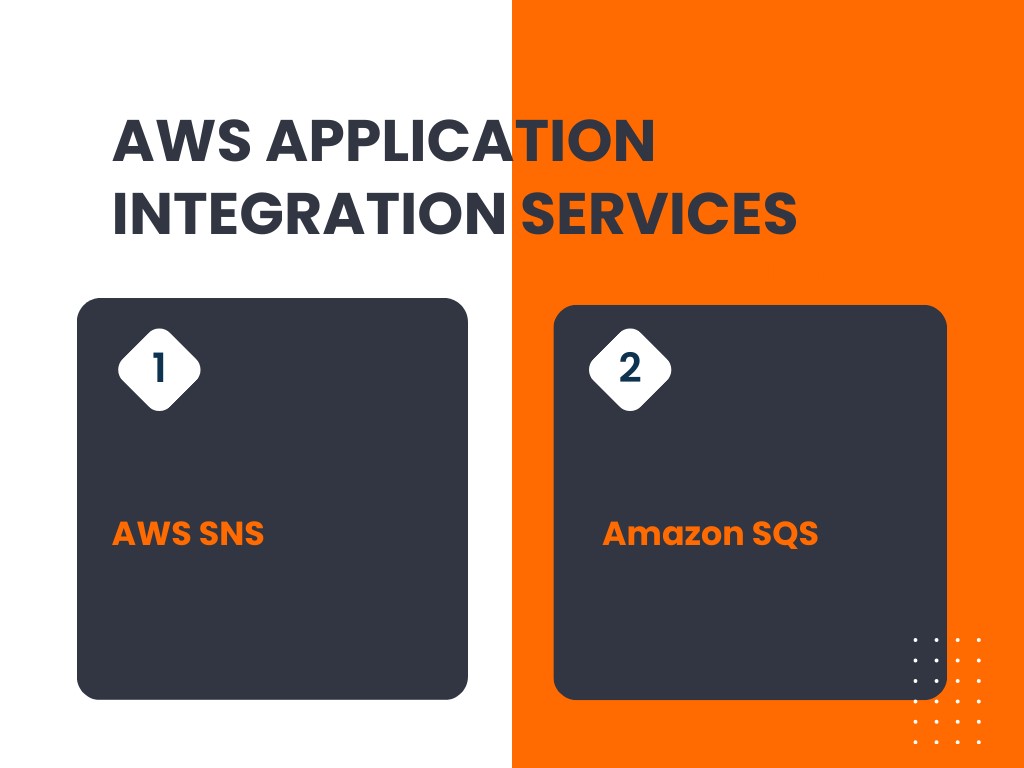
Amazon SNS (Simple Notification Service): A pub/sub messaging service for easy and secure communication between application components.
Amazon Simple Queue Service (SQS): A message queuing service for decoupling and scaling distributed components in applications.
What is AWS Architecture and How does it work?
Let’s break down how AWS architecture works using a web hosting scenario, a common use for the platform. This setup demonstrates how AWS components collaborate to build a reliable, scalable, and secure web hosting environment, ensuring high availability, optimized costs, and efficient resource management.
Step 1: Amazon Route 53 (Domain Name System – DNS)
The journey starts with Amazon Route 53, managing domains and directing incoming traffic to the right resources. You set up your domain to connect with your AWS infrastructure using Route 53.
Step 2: Elastic Load Balancer (ELB)
Incoming web traffic first reaches the Elastic Load Balancer, distributing it evenly across multiple Amazon EC2 instances for high availability and fault tolerance.
Step 3: Amazon EC2 Instances
These virtual servers host web applications and services, allowing you to choose the type and size based on your workload. Auto Scaling groups can adjust the number of instances automatically as demand changes.
Step 4: Amazon RDS (Relational Database Service)
If your web app uses a relational database like MySQL or PostgreSQL, Amazon RDS handles tasks like patching, backups, and scaling.
Step 5: Amazon S3 (Simple Storage Service)
For static assets like images and CSS files, Amazon S3 offers scalable and durable object storage, often used for hosting website content and linked to a CDN also known as Content Delivery Network for faster delivery.
Step 6: AWS Lambda
AWS Lambda runs code without managing servers, suitable for tasks like image resizing and processing user uploads.
Step 7: Amazon CloudWatch
CloudWatch monitors and collects operational data in real-time, helping track resource performance, set alarms, and automate responses to defined events.
Step 8: Amazon VPC (Virtual Private Cloud)
A Virtual Private Cloud isolates the web hosting environment, allowing configuration of network settings and access control.
Step 9: Security Groups and Network ACLs
Security Groups and Network Access Control Lists various inbound and outbound traffic to EC2 instances and other AWS resources, enhancing security.
Step 10: IAM (Identity and Access Management)
IAM ensures security for AWS resources, setting permissions and access controls for users and services.
The Companies That Use AWS
1. Netflix
Netflix relies on AWS for its streaming services. AWS provides the necessary scalability and reliability to handle the massive amounts of data traffic that Netflix generates, especially during peak viewing hours. AWS’s global infrastructure also enables Netflix to deliver content to users worldwide efficiently.
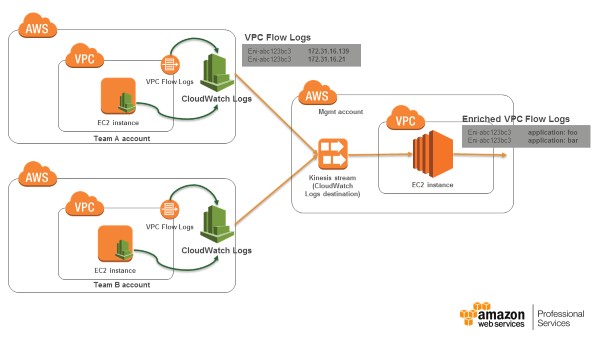
Image source: aws.amazon.com
2. Amazon
Amazon, the parent company of AWS, extensively uses its cloud services for various purposes including its e-commerce platform, Amazon Prime Video streaming service, Alexa voice assistant, and more. By leveraging AWS, Amazon can scale its operations rapidly and efficiently without worrying about managing physical infrastructure.
3. Facebook
Facebook utilizes AWS for various purposes, including content delivery and data analytics. While Facebook operates its data centers, it relies on AWS to support its services during peak usage periods and for handling specific workloads. Additionally, Facebook benefits from AWS’s advanced machine learning and AI services for enhancing its platform features.
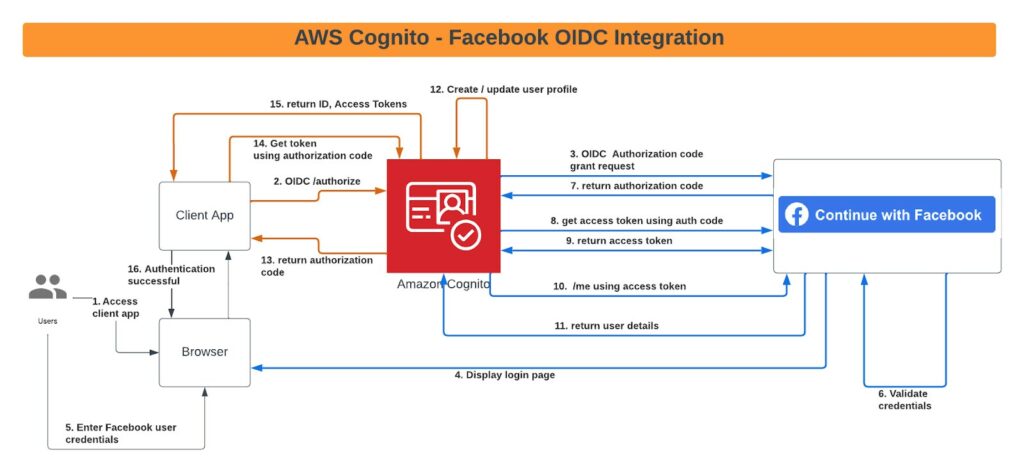
Image source: awskarthik82.medium.com
4. Airbnb
Airbnb employs AWS to power its online marketplace for lodging and tourism experiences. AWS provides the scalability and reliability needed to handle Airbnb’s dynamic workload, especially during high-demand periods and seasonal fluctuations. Additionally, AWS’s global presence helps Airbnb deliver consistent performance to users worldwide.
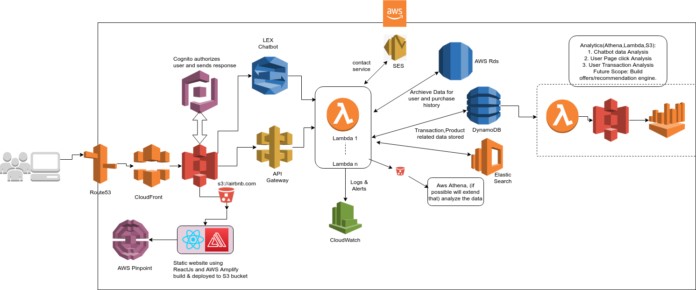
Image source: rahulkprajapati.medium.com
5. Slack
Slack relies on AWS for its messaging and collaboration platform. AWS’s infrastructure enables Slack to handle millions of concurrent users, ensuring high availability and low latency for real-time communication. Slack also leverages AWS’s advanced security features to protect user data and ensure compliance with regulatory requirements.
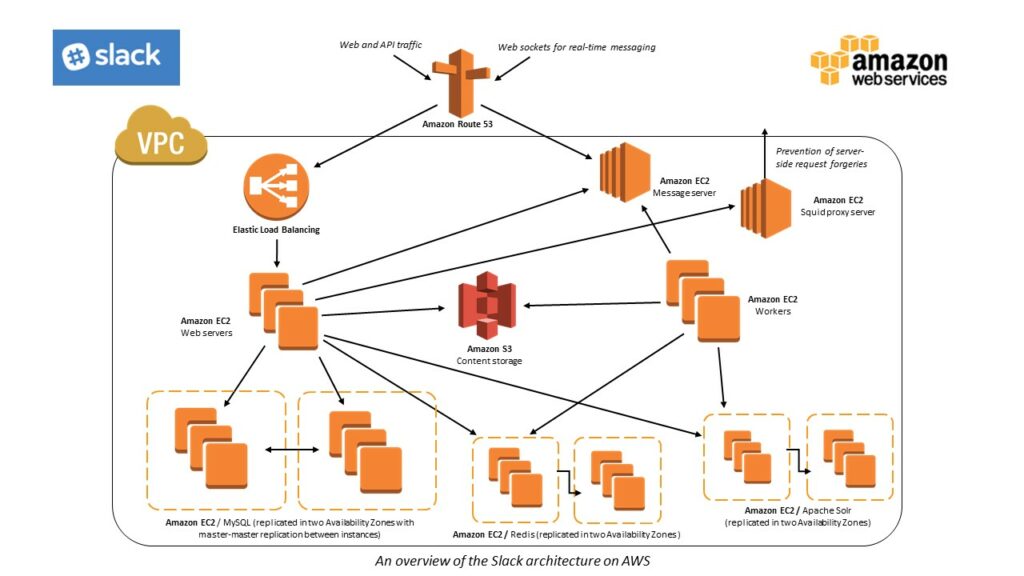
Image source: aws.amazon.com
6. NASA
NASA utilizes AWS for various scientific computing and data analysis tasks. AWS’s high-performance computing capabilities enable NASA to process large datasets and run complex simulations more efficiently than traditional on-premises infrastructure. Additionally, AWS’s cloud storage services allow NASA to store and analyze vast amounts of space-related data cost-effectively.
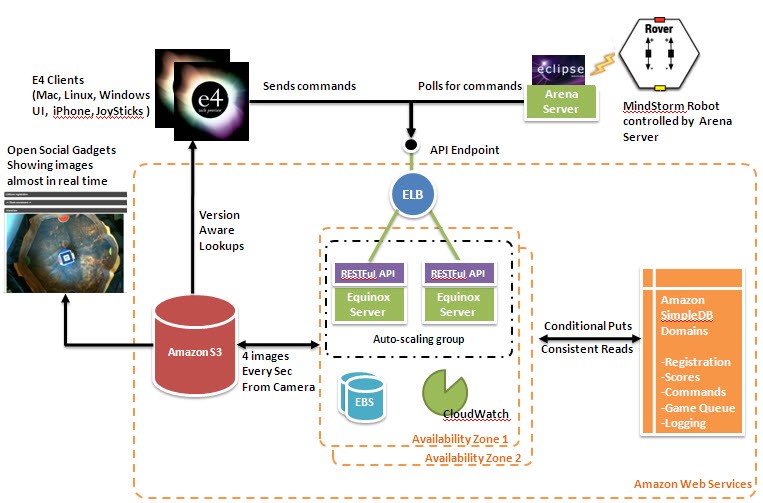
Image source: aws.amazon.com
7. Pinterest
Pinterest uses AWS to power its social media platform for discovering and sharing ideas. AWS’s scalability allows Pinterest to handle rapid user growth and fluctuations in demand, ensuring a seamless user experience. Additionally, AWS provides Pinterest with a comprehensive portfolio of services for data storage, analytics, and machine learning, enabling the company to personalize content and improve user engagement.

Image source: aws.amazon.com
Conclusion
In conclusion, Amazon Web Services (AWS) is an end-to-end cloud computing platform offered by Amazon.com. It provides a wide range of cloud services, including computing power, storage solutions, networking capabilities, databases, machine learning tools, and more. AWS allows businesses and developers to deploy applications, build in real-time, analyze and store data, and scale their infrastructure rapidly and cost-effectively. With its extensive global network of data centers and a vast array of services, AWS has become a cornerstone of modern technology infrastructure, empowering organizations of all sizes to innovate and grow in the digital age. Therefore, if you’re looking for a career in AWS, check out these trendy AWS Certifications.

© 2022 spoclearn.com